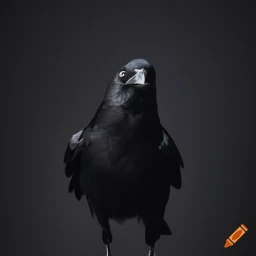Get to Know the Exotic Corvus Culminatus – Indian Jungle Crow
December 30, 2023 | by BlackCrow.com

Meet the Indian Jungle Crow
Introducing the Corvus Culminatus
The Indian Jungle Crow, scientifically known as Corvus culminatus, is a fascinating bird native to the South Asian region. With its distinctive appearance and remarkable behaviors, this crow species has captured the attention of bird enthusiasts and researchers alike. Let’s explore the unique characteristics of this intriguing bird.
Habitat and Distribution
The Indian Jungle Crow primarily inhabits the dense forests and woodlands of South Asia, including countries such as India and Burma. These intelligent birds have adapted well to a variety of habitats, including urban areas, where they can be commonly spotted scavenging for food.
Their distribution extends across the Indian subcontinent, with populations found in different states of India and neighboring regions. The Indian Jungle Crow is known for its versatility in adapting to various environments, which has contributed to its widespread presence in the region.
To learn more about other species of crows, you may be interested in our articles on Corvus albus – Pied Crow (Central African coasts to Southern Africa) or Corvus bennetti – Little Crow (Australia).
The Indian Jungle Crow’s habitat and distribution make it an integral part of the ecosystem in South Asia. Understanding more about this remarkable bird will provide a deeper appreciation for its role in the natural world.
Identifying Features
To recognize the Indian Jungle Crow (Corvus culminatus) in the wild, it’s important to be familiar with its distinctive size, appearance, plumage, and coloration.
Size and Appearance
The Indian Jungle Crow is a medium-sized bird, measuring approximately 40-46 centimeters (15.7-18.1 inches) in length. It has a sturdy build with a strong beak and prominent claws. Despite the blackcrows size, the Indian Jungle Crow is agile and capable of swift flight.
Plumage and Coloration
The plumage of the Indian Jungle Crow is primarily black, with a glossy sheen that catches the light. Its feathers are sleek and smooth, contributing to its elegant appearance. The wings and tail are slightly rounded, allowing for precise maneuverability during flight.
In terms of coloration, the Indian Jungle Crow exhibits minimal variation within its species. However, close observation reveals subtle differences in the color of the feathers, particularly on the head and neck. These variations can be attributed to factors such as age, diet, and individual genetics.
It’s important to note that distinguishing the Indian Jungle Crow from other crow species can be challenging, as they may share similar physical characteristics. If you want to learn more about different crow species, check out our articles on the Pied Crow, Little Crow, Cape Crow, American Crow, Hooded Crow, and Carrion Crow.
By understanding the identifying features of the Indian Jungle Crow, you can appreciate its unique characteristics and distinguish it from other crow species.
Life in the Jungle
The Indian Jungle Crow, scientifically known as Corvus culminatus, thrives in the diverse landscapes of South Asia. Let’s take a closer look at their diet and feeding habits, as well as their social behavior and communication.
Diet and Feeding Habits
Indian Jungle Crows have an omnivorous diet, which means they consume both plant and animal matter. Their diet consists of a wide range of food sources, including fruits, seeds, insects, small mammals, eggs, and carrion. These highly adaptable birds are often seen foraging on the ground, searching for insects and small animals. They are also known to scavenge from garbage dumps and urban areas, taking advantage of human food waste.
To access their food, Indian Jungle Crows use their strong beaks to probe, peck, and even tear apart their prey. They are intelligent and resourceful birds, capable of using tools to obtain food. For example, they have been observed dropping hard-shelled nuts onto roads, allowing vehicles to crack them open. This behavior showcases their problem-solving skills and adaptability.
Social Behavior and Communication
Indian Jungle Crows are highly social birds that form large flocks. These flocks can consist of several hundred individuals, and they often gather in communal roosting sites at night. Within these flocks, they establish complex blackcrow social hierarchies, with dominant individuals having priority access to resources.
Communication plays a crucial role in the social dynamics of Indian Jungle Crows. They use a variety of vocalizations, including calls, caws, and squawks, to communicate with each other. These vocalizations serve various purposes, such as warning others of potential threats or signaling the location of food sources. They also use body language, such as wing displays and posturing, to convey messages to other members of their flock.
In addition to vocal and visual communication, Indian Jungle Crows are known for their ability to recognize and remember individual faces. This helps them establish relationships within their flock and distinguish between familiar and unfamiliar individuals.
Understanding the diet, feeding habits, social behavior, and communication patterns of Indian Jungle Crows provides valuable insights into their fascinating lives in the jungle. These intelligent and adaptable birds have managed to thrive in diverse environments, demonstrating their ability to adapt and survive in a changing world.
Adaptations and Intelligence
The Indian Jungle Crow, scientifically known as Corvus culminatus, possesses remarkable adaptations and displays impressive intelligence. These characteristics contribute to their survival in their natural habitat. Let’s explore their tool use and problem-solving skills, as well as their nesting and breeding habits.
Tool Use and Problem-Solving Skills
The Indian Jungle Crow showcases exceptional problem-solving skills and an aptitude for tool use. They have been observed using various objects as tools to extract food from hard-to-reach places. For example, they have been seen using sticks or twigs to extract insects from tree crevices or to dig out grubs from the ground.
Their ability to adapt objects for specific tasks highlights their cognitive flexibility. This intelligence allows them to overcome challenges and access food sources that may be otherwise inaccessible. The Indian Jungle Crow’s tool use and problem-solving skills demonstrate their remarkable ability to adapt to their environment.
Nesting and Breeding Habits
The nesting and breeding habits of the Indian Jungle Crow are fascinating to observe. They usually build their nests high up in trees, using a combination of twigs, leaves, and other materials. The nests are often large and sturdy, providing a safe haven for their offspring.
Mating pairs of Indian Jungle Crows are typically monogamous and form strong bonds. They engage in elaborate courtship displays, which often involve intricate aerial maneuvers and vocalizations. Once the female lays her eggs, both parents take turns incubating them and caring for the hatchlings.
The Indian Jungle Crow’s nesting and breeding habits showcase their dedication to family and their ability to raise their black crow young successfully. These behaviors contribute to the survival and growth of their population.
By understanding the tool use and problem-solving skills, as well as the nesting and breeding habits of the Indian Jungle Crow, we gain a deeper appreciation for their adaptability and intelligence. These attributes play a significant role in their ability to thrive in their natural habitat.
Conservation Status
The Indian Jungle Crow (Corvus culminatus) is a fascinating species that is native to the South Asian region. While it is not currently listed as a globally threatened species, there are certain threats that pose risks to its population. Conservation efforts are crucial to ensure the long-term survival of this unique crow species.
Threats to the Indian Jungle Crow
The Indian Jungle Crow faces a range of threats that impact its population. These threats include:
- Habitat Loss: Deforestation and urbanization lead to the destruction and fragmentation of the crow’s natural habitat. As forests are cleared for agriculture, infrastructure development, and human settlements, the Indian Jungle Crow’s nesting and foraging areas are significantly reduced.
- Human Interactions: The Indian Jungle Crow often comes into conflict with humans due to its scavenging behavior. It may be considered a nuisance in urban areas where it feeds on garbage and crops, leading to negative interactions with humans.
- Pesticide Use: The use of pesticides in agricultural practices can have detrimental effects on the Indian Jungle Crow. Consumption of pesticide-contaminated food sources can lead to poisoning and adversely affect the crow’s health and reproductive success.
- Hunting and Persecution: In some areas, the Indian Jungle Crow is hunted or persecuted due to its perceived nuisance or for its feathers, which are sometimes used in traditional rituals or crafts.
Conservation Efforts and Future Outlook
Efforts are being made to conserve the Indian Jungle Crow and address the threats it faces. These initiatives include:
- Habitat Protection: Establishing protected areas and wildlife corridors can help safeguard the crow’s habitat and ensure the availability of suitable nesting and foraging sites.
- Public Awareness and Education: Educating local communities about the importance of conserving the Indian Jungle Crow and the role it plays in the ecosystem can foster a positive attitude towards the species. This can encourage coexistence and reduce conflicts.
- Pesticide Regulation: Implementing strict regulations and guidelines for pesticide use can minimize the negative impact of chemical substances on the Indian Jungle Crow and other wildlife.
- Research and Monitoring: Conducting scientific studies on the behavior, ecology, and population dynamics of the Indian Jungle Crow can provide valuable insights for conservation planning and management.
While the Indian Jungle Crow currently faces threats, the implementation of conservation measures and increased awareness can contribute to its long-term survival. By protecting its black crow habitat, minimizing human-wildlife conflicts, and promoting sustainable practices, we can ensure the continued presence of this unique and important member of South Asia’s biodiversity.
For more information on different crow species, check out our other articles on Blackcrow.
RELATED POSTS
View all


